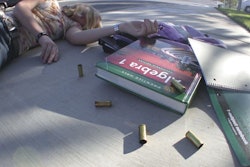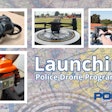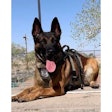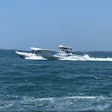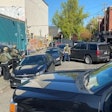In this age of technology, counterfeiting has become an even easier and more lucrative operation. Many gangs have realized this and take full advantage of such "business opportunities."
There are several types of counterfeit operations gang members can be involved in. Paper operations include forging checks, as well as creating counterfeit traveler's checks, identification, and even bus passes. For these criminal enterprises, losses can reach hundreds of thousands of dollars.
Even more lucrative are high-tech operations that include the illegal duplication of movies, music, and computer software. Needless to say, this type of counterfeiting has become the operation of choice. Due to the advanced computer technology available, gray and black market cash, and local and international connections, millions of dollars of non-recorded income a month can be generated.
As a cop, it's useful to know how gang members and other criminals make counterfeit software, movies, and music CDs so you know what to look for. To investigate, you should also know how to determine whether or not a CD is counterfeit. These operations might be more prevalent than you think.
Duplication machines are commonly used in legitimate business practices. However, unscrupulous business owners sometimes use their machines to illegally duplicate thousands of copies of copyrighted material. The new duplication processes can produce thousands of CDs in just a few hours. Finding such an operation and shutting it down can make a great impact.
Master Copies
If someone were going to illegally duplicate a current popular movie, he would buy a legitimate copy of it at a video store. The information from that movie would first need to be placed on a DLT tape. The tape is a little larger than the size of a VHS video tape. A special computer program transfers the audio and video information from the legitimately bought disc to the DLT tape.
This DLT tape becomes the master for a master CD or DVD, often called the "stamper." The information from the DLT tape is stored in a specialized format and is used to manufacture the stamper. The DLT tape can be used to make several stampers.
In non-technical terms, think of the stamper as the CD or DVD negative. One of these light metal discs must be made for each software, music, or movie title to be duplicated. One stamper costs around $400 to make, but it can be used to make up to 50,000 copies.
Once created, the stamper is placed in a machine that transfers the information to blank CDs or DVDs. The whole process is automated and controlled by computers. The machines the stamper is placed in can cost from $900,000 to $1 million each.
DLT tapes and stampers can be great evidence of a counterfeit duplication operation.
Duplication
Once a stamper has been manufactured, the duplication process can be started. The duplication machine is large in size and looks complicated. This is because it contains many automated and moving parts. Owners of these machines have stated that it can take more than a week to get the machine set up and operational. In legitimate businesses, the machines are set up in a clean room. Normally, people wear an outer protective paper jumpsuit and mask to ensure that no contaminants are introduced into the manufacturing process. In other words there is quality control.
The clean rooms you find in counterfeit operations are a little different. I have seen clear plastic panels acting as the doorway into the manufacturing area. Sometimes the rooms where the machines are located are air-conditioned to compensate for the heat produced as the machines operate. Clear plastic pellets are transferred from large plastic bags to the machines via large vacuum-cleaner-like suction tubes. The machine melts the plastic pellets and reshapes them to form a basic CD. The machine can manufacture thousands of these raw CDs with precise accuracy. Each CD made is of standard size and weight and is balanced to spin correctly.[PAGEBREAK]
Once the raw CD is made, mechanical arms place it onto a platen, which is a plate that spins. While it is spinning, the reflective aluminum-colored coating is sprayed onto the CD. The process is fast and the coating instantly dries. The fresh CD is then placed onto a large rotating plate that holds four or five raw CDs. Each raw CD is rotated under the stamper. The stamper is pressed onto the CD, transferring the data from the "master" onto the new CD.
This process literally takes a few seconds. It is easy to see how thousands of CDs can be manufactured in just a few hours, especially if two or three machines are running at once.
The discs at this point are not labeled and appear to be blank, like the ones you would buy to burn using your home computer and a CD or DVD read/write program. To complete the duplication process, the label of the legitimate product is copied and made into "artwork." Artwork is a photographic negative of what is to be printed onto the CD. Silk screening is commonly used, but there are specially made printers that can print labels on thousands of discs per hour.
Once the label is printed onto the disc, two things can happen. The discs may be packaged in bulk and shipped to another location to be individually packaged and shipped. Or the same manufacturer may individually package the discs and ship them to the person who ordered them.
The Price of Doing Business
Right now, legitimately manufactured music CDs cost approximately 75 to 80 cents to make. This price does not include the extra costs of royalty fees, handling, packaging, shipping, and advertisement. By the time these costs are factored in, in addition to mark-up, you and I will pay $15 to $20 per title.
Counterfeit copies cost the purchaser $1.25 to $1.50 per copy in bulk quantities. Because the manufacturers of counterfeit copies don't need to cover the overhead costs necessary in legitimate operations, they more than make up the difference in the cost per CD copy. The math is not hard; counterfeiting CD operations can net more than $1 million a month for the manufacturer. And if the owner/operator is engaged in legitimate business, it becomes easy to conceal counterfeiting operations.
Counterfeit CDs of music and software are sold at swap meets, online, and through mail order. The "sell out," "close out," or "special offer" sales on the Windows 2000 operating system for $99, or Norton Utilities for $29.99, or a DVD movie like "Spider-man" for $10 will probably get the purchaser a counterfeit copy.
Although they are cheaper, counterfeit CDs and DVDs have drawbacks for consumers. They do not carry the warranties that legitimately manufactured discs do. This is really a concern for users of counterfeit software. If an operating system fails and a counterfeit copy was purchased and used, you will not get any manufacturer support or compensation. And you will still have to purchase a legitimate copy of the software to get your system running.
If you suspect a CD or DVD of being counterfeit, examine the inner center area of the disc. It is called the inner mirror band. This is where, on legitimately manufactured discs, you will find the name of the company that manufactured the title. If the name is missing, the disc may be counterfeit.
There may also be numbers embossed in this area. The numbers are called PIP numbers and are for identification purposes, similar to the ISB number assigned to books. But the presence of one set of numbers may only indicate a numbered production run.
Also, the graphics on the front of the disc should be crisp and readable. The producer's name should be on the front cover. The cover may also contain copyright information.
Gangs on the Job
Where do gangs figure in? Well, many gang members are involved in counterfeit operations in various ways. Some gang members work at CD and DVD manufacturing plants, giving them legitimate industry experience to use in a counterfeit operation. Gang members are also sometimes used to transport or sell counterfeit CDs. These gang members might also hijack semi trucks that are loaded with legitimately manufactured CDs. These stolen discs can then be copied and or sold for cheap prices. Older gang members are often involved in these high-tech crimes.
Investigations into counterfeit CD operations might be lengthy and, more often than not, will require an informant or undercover investigator. But cases like these can be initiated if the right questions are asked of a gang member who is involved. Keep your eyes open and talk to the right people and you just might crack a case using sources others might not think to tap.
Al Valdez is an investigator with the Orange County (Calif.) District Attorney's office and author of the book, "Gangs."




